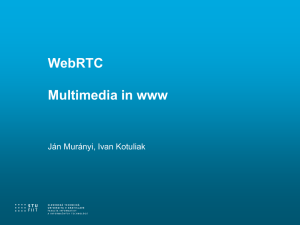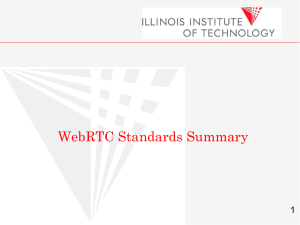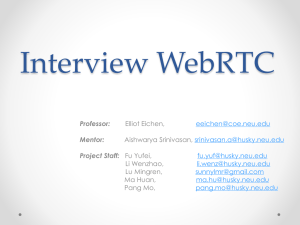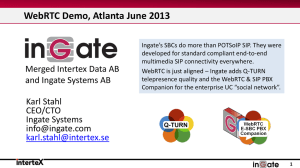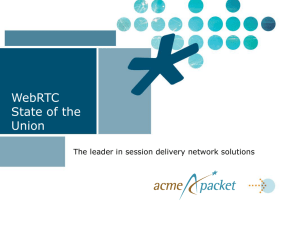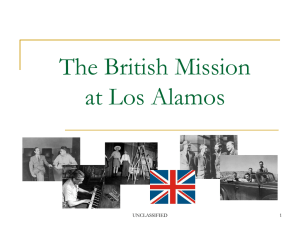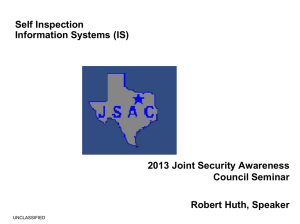SA3LI13_136r1
advertisement
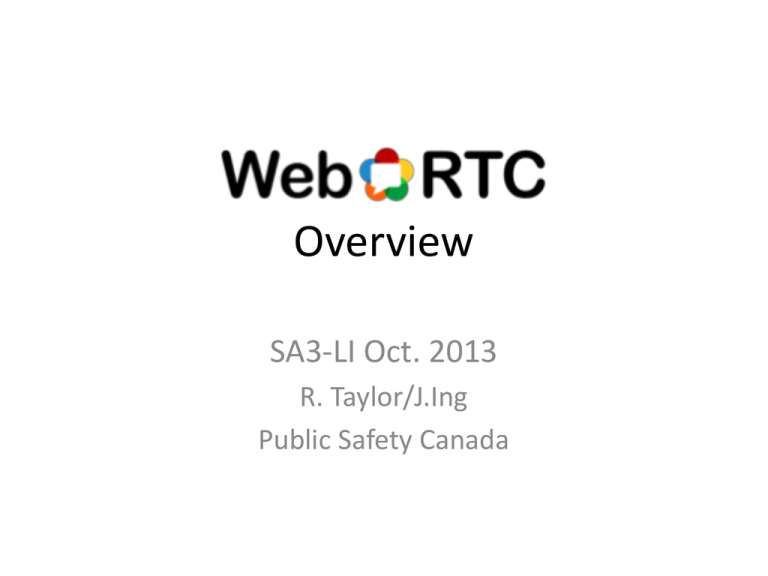
Overview SA3-LI Oct. 2013 R. Taylor/J.Ing Public Safety Canada What is it • Web Real-Time Communications • Standards to enable browser based sessions (voice, video, Collab, …) without the need of custom clients or plugins • Builds on HTLM5 capabilities with JavaScript • Standardized by W3C and IETF – IETF RTCWeb WG ( Internet world, IP protocols) – W3C WebRTC WG (web world, Browsers etc.) • Intended for all browsers to support – Chrome, Firefox, Safari, Opera, IE … • MSFT being problematic – Have their own CU-RTC-Web framework • Apple (Safari) not at the table 4/8/2015 Unclassified 2 High Level Model • Web Server/service based signaling brokering – Offer/Answer model with SDP; protocol NOT defined • Direct media flow, sometimes relayed due to NAT/NAPT – SRTP/RTCP 4/8/2015 Unclassified 3 Evolving towards a convergence point • • IMS – In standards development for 13+ years – 3GPP(2)/TISPAN resolved ambiguities and created a SIP profile to meet extensive requirements of fixed/cellular service providers WebRTC – In standards development for ~2 year – Requirements driven by “web” community Operator requirements centric PSTN/Cellular NGN IMS Interworking & technology blending WebRTC • • WebRTC will evolve and interwork with IMS IMS will adapt to support WebRTC – 3GPP TR 23.701 V0.1.0 (2013-07) – Web Real Time Communication (WebRTC) Access to IMS; (IMS-WEBRTC) – Rel 12 Technical Report WebRTC maturing very quickly, goals and priorities differ from IMS 4/8/2015 Unclassified Proprietary real time communications based on Plug-ins HTTP Web Browser Internet requirements centric 4 Projected Adoption “WebRTC will be available -- that is, downloaded and installed -- on over 4 billion devices within the next three years, according to the International Telecommunication Union (ITU)'s projections” 4/8/2015 Unclassified 5 WebRTC Peering SDP Offer SDP Answer Signalling Path Web Server Application defined interface (HTTPS / Websockets based) Protocol not defined (possibilities include SIP, Jingle, XMPP) Web Server Application defined interface (HTTPS / Websockets based) JS/HTML/CSS JS/HTML/CSS JavaScript API JavaScript API Media Path Browser Browser Peer to Peer - Transport framework based on SRTP • Solution geared towards web community and deliberately left open • Standardizing the required Browser behaviour, NOT the End-to-End solution 4/8/2015 Unclassified 6 Details 4/8/2015 Unclassified 7 Under the covers Parts in blue are “a” TSP’s view, not part of Standards activities 4/8/2015 Unclassified 8 Solution Details • • Web page invokes set of defined JavaScript's to request services from the browser Interface/Protocol between scripts and browser: JSEP – Java Session Establishment Protocol – Create an Offer, Create an Answer, get media details (SDP), Invoke ICE, etc. – Implements Offer/Answer model like used in SIP • Offers, Answers etc. sent to/via Web server – Uses HTTPS or secure WebSockets (RFC 6455) • • Provides full-duplex communications channels over a single TCP connection Uses ICE for NAT traversal (RFC 5245) – Interactive Connectivity Establishment (ICE): • A Protocol for Network Address Translator (NAT) Traversal for Offer/Answer Protocols – Complicated set of procedures using STUN and TURN to discover best addresses to use for RTP streams • Web server pushes notification to “called” party – Requires browser to be open and excepting – Inter -Server protocol not defined • Secure RTP for media exchange – Using DTLS (Datagram TLS) • use of SDES (Session Description Protocol Security Descriptions) has been disallowed by the IETF – RTP and RTCP multiplexed on same port (RTCP usually on RTP port plus one) – A media relay service (TURN) may be required 4/8/2015 Unclassified 9 Now a word about Codecs • G711a/u (RFC 3551) – Mandated – supported by all the devices – Tends to use a lot of bandwidth • DTMF tones (RFC 4733, updates RFC 2833) – needed for interactions with legacy systems – Voice mail, IVRs, … • Opus (RFC 6716): – – – – Mandated Variable bitrate, low latency and high quality for human voice and music Specifically designed for real time communications Supposedly Patent unencumbered hence royalty free • Ongoing battle in video VP8/9 vs H.264/265 – Royalty free ? vs. MPEG world – No Flash • Proposals to support other Codecs if available on the device – E.g., AMR, AMR-wb 4/8/2015 Unclassified 10 WebRTC interworking Signalling Path Web Server Signalling Interworking ICE-Lite* Media Interworking JS/HTML/CSS Browser Media Path (SRTP) Interworking Function Interconnect to IMS, NGN and PSTN networks (RTP) * ICE is key to determining a viable media path and user consent. ICE interworking required at gateway if not supported at downstream endpoint. The underlying offer/answer model and RTP based media assist with interworking to IMS/SIP networks 4/8/2015 Unclassified 11 Possible Operator models Scenario 1: Interconnect to 3rd party WebRTC 3rd Party Web Domain Web Server TAS Signalling Interworking Media Media Interworking Signalling Interworking Web Server IMS IMS /NGN core ICE-Lite JS/HTML/CSS Operator run Web Service I-SBC WebRTC Signalling Scenario 2: WebRTC as pseudo IMS end point JS/HTML/CSS Media UE Browser WebRTC Signalling Web Server JS/HTML/CSS JS/HTML/CSS Media Browser 4/8/2015 IMS P-CSCF Media Media Interwor king IMS core Media UE IMS Network Operator Scenario 3: Native support of WebRTC Web Server TAS IMS SIP Browser IMS Network Operator Operator run Web Service A-SBC Operator product requirements depends on commercial strategy: • Border interconnect between PSTN/NGN/IMS and WebRTC • WebRTC end points as an extension to an NGN/IMS network • Native support of WebRTC Browser Unclassified 12 W3C WebRTC deliverables • – • - Implementation Library: WebRTC Native APIs An extension of the Media Stream Functions to process audio streams (e.g. automatic gain control, mute functions and echo cancellation). - Media Capture and Streams - Draft 16 May 2013 • An extension of the Media Stream Functions to process video streams (e.g. bandwidth limiting, image manipulation or "video mute“). Supported by Chrome and Firefox NOW - Pre-standard Functional Component Functions – • API specification Availability - WebRTC 1.0: Real-time Communication Between Browsers Draft 3 June 2013 available Video Stream Functions – • API for connecting processing functions to media devices and network connections, including media manipulation functions. Audio Stream Functions – • • Media Stream Functions API to query presence of WebRTC components in an implementation, instantiate them, and connect them to media streams. P2P Connection Functions – API functions to support establishing signalling protocol agnostic peer-to-peer connections between Web browsers 4/8/2015 Unclassified 13 IETF Deliverables • • • • • • • • • Communication model Security model Firewall and NAT traversal Media functions Functionalities such as media codecs, security algorithms, etc., Media formats Transport of non media data between clients Input to W3C for APIs development Interworking with legacy VoIP equipment WG RFC draft-ietf-rtcweb-audio-02 draft-ietf-rtcweb-data-channel-05 draft-ietf-rtcweb-data-protocol-00 draft-ietf-rtcweb-jsep-03 draft-ietf-rtcweb-overview-07 draft-ietf-rtcweb-rtp-usage-07 draft-ietf-rtcweb-security-05 draft-ietf-rtcweb-security-arch-07 draft-ietf-rtcweb-transports-00 draft-ietf-rtcweb-use-cases-and-reqs-11 Plus over 20 discussion RFC drafts Date 2013-08-02 2013-07-15 2013-07-15 2013-02-27 2013-08-14 2013-07-15 2013-07-15 2013-07-15 2013-08-19 2013-06-27 • IETF currently 6-9 months behind schedule • Content prioritisation starting to taking place 4/8/2015 Unclassified 14 Other SDO Activity A B C D • ATIS ORCA – – – – Open Real‐time Communications API Open source project Announced July 24, 2013 Provides client‐side call control APIs • Simplifies the signaling to set up high quality communication sessions between web applications – Provides tools and JavaScript libraries – Fits existing developer model 4/8/2015 Unclassified 15 The Tricky Bits • Identity resolution – Ok if in a wall-garden solution (Facebook, Twitter, Google circles, …) – Ok for “Call Now” button on Personal & Business Web pages • Assuming there’s someone manning the website – But how can Alice “call” Bob just browser to browser ? • How to resolve Bob’s address to Web Server and Bob’s browser instance – Public ENUM (Phone # to URL) failed • NAT/NAPT traversal – ICE is heavy weight, not web developer “friendly” – If media relay is required, who supplies the TURN servers ? • Security – Lots of focus on the protocols – But browsers and JavaScript ripe with potential/real exploits – SPAM & Unwanted call control/mitigation • RTP stream multiplexing – RTP + RTCP – Multiple RTP streams • Interworking – – – – 4/8/2015 Between WebRTC solutions With established OTT solutions (Skype, Viber, etc.) With NGN/IMS Legacy PSTN and PLMN Unclassified 16 LI Concerns and/or Issues • Who’s providing the “Service” – Regulated, Unregulated, Mix ? – Depends a lot on the nature of the solution • TSP IMS controlled vs. just a “Call Me” button on a web page • What Ids are being used/resolved ? – By whom and how ? – In a regulatory domain ? • Detecting the service – Security posture is specifically around blocking man-in-the-middle (“The Man”-in-the-middle ?) attacks – Is the signaling reasonably detectable ? – Protocols being used ?? – Encryption • Location not part of the solution space: Jurisdiction – Where’s the client/browser vs. Web Server(s) • Media Interception – – – – Where is the bearer really going, passing through ? Forcing media relays when not required ? RTP multiplexing Media Encryption (DTLS) • Who has the keys ? • No LEA influence over lead SDOs – IETF and W3C not “LI friendly” 4/8/2015 Unclassified 17 Backup 4/8/2015 Unclassified 18 Browser Support 4/8/2015 Unclassified 19 End 4/8/2015 Unclassified 20
